A scientific look at antiperspirants
AUTHORS Philip B Klepak – Independent Consultant, US
Barbara M Schmidt PhD, Independent Consultant – US
PUBLISHED in Personal Care Europe
In recent years, some products of plant origin have been shown to be effective chemotherapeutic agents demonstrating measureable biological activity without exerting undesirable side effects. This article addresses whether some plants contain sufficient bioactive phtyochemicals that could function as ‘natural’ antiperspirants when applied from a topical formulation.
The terms antiperspirant and deodorant are often used interchangeably in publications, but this is confusing, as there are true differences between them, especially with respect to regulatory classification, functionality, and the types of ingredients currently used. The first step, therefore, is to briefly understand the current state of the art.
Antiperspirants versus deodorants
In the US, antiperspirants are classified as over-the-counter (OTC) drugs. The Food and Drug Administration (FDA) defines a drug as “an article intended for use in the diagnosis, cure, mitigation, treatment, or prevention of disease and/or an article (other than food) intended to affect the structure or function of the human body and/or an article intended for use as a component of such an article.”
Antiperspirants reduce underarm sweating/wetness by forming temporary superficial plugs in the sweat glands thereby decreasing the amount of sweat that reaches the skin surface. As sweating is a bodily function, antiperspirants conform to the definition of a drug product. The only currently approved active ingredients for antiperspirants are aluminium or aluminium zirconium-based metallic salts.
In contrast, deodorants are classified as cosmetics in the US. The Food, Drug, and Cosmetic (FD&C) Act defines cosmetics as “articles intended to be rubbed, poured, sprinkled, or sprayed on, introduced into, or otherwise applied to the human body…for cleansing, beautifying, promoting attractiveness, or altering the appearance.” Deodorants are one of the product classes included in this definition, as they are formulated to neutralise or mask underarm odour caused by the bacterial breakdown of perspiration. They do not reduce sweating. A large variety of ingredients are used in deodorants including but not limited to fragrances, antimicrobial agents, baking soda, natural essential oils, astringents, zinc oxide (ZnO), chelating agents, etc.
True antiperspirants also act as deodorants because they exert antimicrobial activity against odour causing microorganisms, and they reduce perspiration, which is necessary for the proliferation of bacteria that cause underarm odour.
Outside the US, antiperspirants are primarily regulated as cosmetics.
Read the full article PDF.
(first published April 2020)
more about antiperspirants in this article “Strategic Development of Botanical Antiperspirants” addresses whether some plants contain sufficient bioactive phytochemicals that could function as “natural” antiperspirants when applied from a topical formulation.

